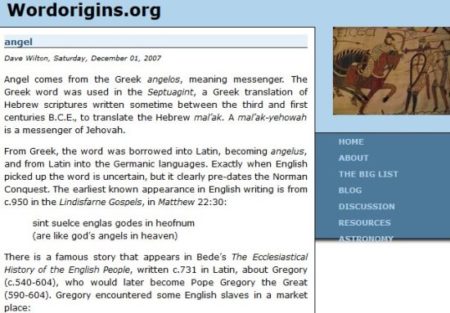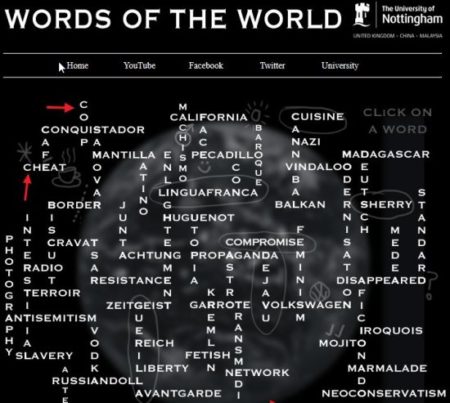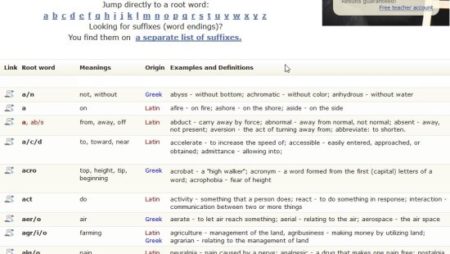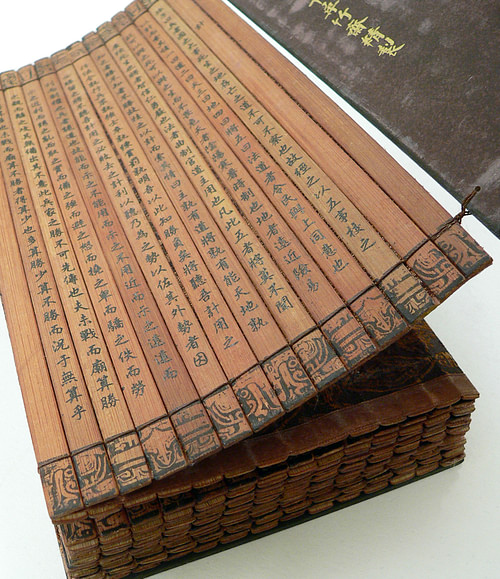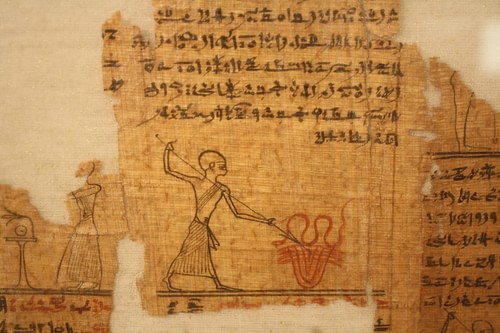Mesopotamia cuneiform
—
The earliest form of writing is cuneiform, which appeared 5,500 years ago in Mesopotamia (present-day Iraq). This was a complex system of characters representing the sounds of Sumerian, the language of Sumer in southern Mesopotamia. The earliest examples of cuneiform are tablets with written inscriptions representing the work of administrators, perhaps of large temple institutions, recording the allocation of rations or the movement and storage of goods. The pictographs were inscribed into the tablet with a sharp instrument. The example pictured dates back to 3100-2900 BCE.
©
Getty Images
The language of learning
—
The first writer in history known by name is the Mesopotamian priestess Enheduanna (2285-2250 BCE). Sumerian, meanwhile, was maintained as the language of learning until at least 200 BCE. The last datable document in cuneiform is an astronomical text from 75 CE.
©
Getty Images
Egyptian hieroglyphs
—
Egyptian hieroglyphic script is a writing system used by ancient Egyptians that employs characters in the form of pictures to represent their language. The Narmar Palette (pictured, both sides), contains some of the earliest hieroglyphic inscriptions ever found. It dates back to around 3200 BCE.
©
Getty Images
Hieratic script
—
The ancient Egyptians were the first to write in ink using reed brushes and pens and using papyrus as a writing surface. This cursive ink writing came to be known as hieratic script, or ‘priestly’ script. Pictured is a fragment of a funerary papyrus of Kahapa with a text from the Book of the Dead written in hieratic script, dated back to c. 525–343 BCE.
©
Getty Images
‘Sacred carvings’
—
The carved and painted letters we see on ancient Egyptian monuments are called hieroglyphs (‘sacred carvings’). Here, a guide pictured in the mid-20th century explains some of the hieroglyphs in the Great Hypostyle Hall of the Precinct of Amun-Re, part of the Karnak Temple Complex near Luxor in Egypt.
©
Getty Images
The Rosetta Stone
—
The Rosetta Stone, a stele made of granitoid, features a decree issued in 196 BCE. The top and middle texts are in Ancient Egyptian using hieroglyphic and Demotic scripts (a script derived from hieratic) respectively, while the bottom is in Ancient Greek. This ensemble helped scholars finally crack the code of hieroglyphics.
©
Getty Images
Phoenician alphabet
—
The Phoenician alphabet developed from the Proto-Canaanite alphabet, during the 15th century BCE. Before then, the Phoenicians wrote with a cuneiform script. The origins of most alphabetic writing systems can be traced back to the Phoenician alphabet. Pictured is a terracotta alphabet tablet from the ancient port city of Ugarit in Syria.
©
Getty Images
Linear B
—
Linear B is a syllabic script that was used for writing Mycenaean Greek, the earliest attested form of Greek (no texts in Linear A have ever been deciphered). The script predates the Greek alphabet by several centuries. This page-shaped tablet inscribed with Linear B dates back to 1400-1375 BCE.
©
Getty Images
Greek alphabet
—
The Ancient Greek alphabet descended from the Phoenician alphabet, which in turn derived from Egyptian hieroglyphics. This 5th-century BCE bronze plate is inscribed with the Achaean alphabet, a local variant of the Greek alphabet.
©
Getty Images
Cretan and Greek scripts
—
The Gortyn code, also known as the Great Code, is written in the Ancient Greek Dorian dialect, spoken in places like southern Italy, Crete, and Rhodes. This 5th-century BCE text is found carved on the wall of a Roman theater at Gortyn in Crete.
©
Getty Images
Elamite script
—
The Elamite cuneiform script was used from about 2500 BCE to 331 CE and is the oldest-known writing system from Iran. Pictured is an inscription of the Persian kings Darius I and Xerxes in three languages: Ancient Persian, Elamite, and Babylonian.
©
Getty Images
Etruscan alphabet
—
The Etruscan alphabet was the alphabet used by the Etruscans, an ancient civilization of central and northern Italy. It’s an alphabet probably derived from one of the Greek alphabets. This 6th-century BCE bronze sheet shows the engraved sequence of the this alphabet. The Latin alphabet evolved from the visually-similar Etruscan alphabet.
©
Getty Images
Latin alphabet
—
The Latin, or Roman, alphabet was originally adapted from the Etruscan alphabet during the 7th century BCE to write Latin. The Latin alphabet is the most widely used alphabet system in the world. Pictured is the inscription from the Shrine of Augustales, the Roman priests dedicated to the cult of Augustus, found at Herculaneum. The shrine dates back to 70-79 CE.
©
Getty Images
Oracle bone
—
The earliest surviving examples of writing in China—inscriptions on so-called «oracle bones»—date back to around 1200 BCE. The engraved Ancient Chinese scripts record questions that were posed to the royal ancestors about topics as diverse as crop rotation, warfare, childbirth, religious rites, and even toothache. Since ancient times, Chinese characters have long been able to represent both concepts and the sounds of spoken language to varying degrees.
©
Getty Images
Mesoamerica
—
Writing evolved throughout Mesoamerica—the area which runs from southern Mexico to Costa Rica— from as far back as 900 BCE. The Olmecs, the earliest-known major Mesoamerican civilization, are known to have developed a crude system of writing. Examples of Zapotec script, another early example of Mesoamerican communication, can be found on tablets displayed at the Museum at Monte Albán (pictured) in Oaxaca, Mexico.
©
Getty Images
Maya script
—
Of the several known pre-Columbian scripts in Mesoamerica, it is the Maya script that appears to be the best developed. The Maya hieroglyphic writing system was a sophisticated combination of pictographs directly representing objects and ideograms (glyphs). The earliest inscription identified as Maya dates to the 3rd century BCE. Pictured is an inscribed ornamental Mayan brick from Comalcalco in Tabasco, Mexico, dated back to 652 CE. The inscription relates to the god Ahkal Te’ Chaahk.
©
Getty Images
Dresden Codex
—
The Dresden Codex is the earliest-surviving book written in the Americas. Surviving the Conquistadors’ burning of thousands of indigenous texts, this rare and valuable document found in Yucatán was painted somewhere between 1000 and 1300 CE by Maya scribes on pressed fig-bark paper coated with lime plaster. The codex was rediscovered in the city of Dresden, Germany, hence the book’s present name. It is located in the museum of the Saxon State Library.
©
Getty Images
Indus script
—
The symbols etched into several stone seals found in the Indus River Valley of Pakistan may be writing. As yet undeciphered, scholars believe this script may contain a mixture of logographic and syllabic components. The society that used these symbols was the culmination of a historical settlement in the Indus region that goes back to at least 7000 BCE. Pictured is a steatite seal with a bull, dated back to 2500–2000 BCE.
©
Getty Images
Nabataean script
—
The origins of the Arabic alphabet can be traced to the writing of the semi-nomadic Nabataean tribes, who inhabited southern Syria and Jordan, northern Arabia, and the Sinai Peninsula. Surviving stone inscriptions like this on rose-colored sandstone in the Nabataean archaeological site of al-Hijr near the northwestern town of al-Ula in Saudi Arabia show strong similarities to the modern Arabic writing system.
©
Getty Images
Arabic script
—
The Arabic alphabet is the second-most widely used writing system in the world after Latin, and the third by the number of users, after the Latin and Chinese scripts. Arabic likely developed in the 4th century CE as a direct descendant of the Nabataean alphabet. Pictured is a manuscript written in the 6th century CE.
©
Getty Images
Rongorongo script
—
A system of writing known as Rongorongo was discovered on Easter Island in the mid-19th century. Several unsuccessful attempts have been made to decipher the script, though it’s believed some of the glyphs represent dates. The name Rongorongo means «to recite, to declaim, to chant out» in Rapa Nui, the native language of Easter Island.
©
Getty Images
Cyrillic script
—
A writing system developed in the 9th–10th century for Slavic-speaking peoples of the Eastern Orthodox faith, Cyrillic script is derived from the Greek uncial script and is known for being written entirely in capital letters. The Cyrillic script is used to write Russian, Bulgarian, Czech, Serbian, and Ukrainian, among other languages. Cyrillic is the third official script of the European Union, following the Latin and Greek alphabets. Pictured is a 18th-century example of the Lord’s Prayer in Cyrillic script.
©
Public Domain
Kanji script
—
Japanese, Korean, and Vietnamese script were each greatly influenced by Chinese writing. Indeed, before the introduction of Chinese characters, no Japanese writing system existed. For example, Kanji, one of the three scripts used in the Japanese language, are Chinese characters, which were first introduced to Japan in the 5th century via the Korean peninsula. Pictured is a page from an album of Japanese and Chinese poems, published in the Azuchi–Momoyama period between 1573 and 1615.
©
Getty Images
Latin script
—
Latin script is the basis for the largest number of alphabets of any writing system. Being the standard script of the English language, it is often referred to simply as «the alphabet» in English. Some of the finest illuminated manuscripts ever created are written in Latin. Pictured is the monogram page from the Book of Kells, produced by Celtic monks around 800 CE.
©
Getty Images
Latin script
—
With the spread of Western Christianity during the Middle Ages, the Latin alphabet was gradually adopted by the peoples of Northern Europe. Latin script was the writing system of choice for royalty and the nobility.
©
Getty Images
Medieval Latin script
—
Pictured: the signatures of Henry VII and Elizabeth of York are set against those of Henry VIII and Catherine of Aragon.
©
Getty Images
Gothic script
—
Gothic script, also known as blackletter, was a script used throughout Western Europe from approximately 1150 until the 17th century. Here, Gothic script in the German language is describing Christ on the Cross between the Virgin and Saint John in a 1510 illustration by German printmaker Albrecht Dürer (1471–1528).
©
Getty Images
Origin of the English language
—
Old English was brought to Great Britain by Anglo-Saxon settlers who arrived on Norse longboats.
©
Getty Images
Old English
—
Old English was the language of the Anglo-Saxons (up to about 1150), an inflected language with a Germanic vocabulary, and very different from modern English. An excellent example of West Saxon Old English writing style is found in the heroic epic poem ‘Beowulf,’ produced between 975 and 1025.
©
Public Domain
Middle English
—
The Middle English period generally falls between 1150 and 1500. Middle English saw significant changes to its vocabulary, grammar, pronunciation, and orthography (spelling, capitalization, punctuation, etc.). Geoffrey Chaucer’s ‘Canterbury Tales,’ written between 1387 and 1400, exemplifies the use of Middle English.
©
Getty Images
We use different languages worldwide to communicate with each other. Every so often we wonder where a word came from. How did a particular word start being used as a common word worldwide and where did it actually originate from. So to find this out we will explore the world of languages and origin of words in this article. This article will cover websites which will let you know the origin of a word.
The study of origin of a word is known as Etymology. You will find that often there are popular tales behind the origin of a word. Most of these tales are just tales and not true, but knowing how the word came into being is equally interesting. So let’s look at these websites to know the origin of words below.
Online Etymology Dictionary
Online etymology dictionary explains you the origin of words and what they meant along with how they would have sounded years back. You would see a date beside each word. This date represents the earliest evidence of this word being used in some sort of written manuscript. Now you can either search for a word you are looking for by typing it in the search box given at the top of the page, otherwise you can browse the words alphabetically. The website has a huge collection of words in it. You can go through the words and find out there origins and meanings as well.
Word Origins by English Oxford Living Dictionaries
Word Origins by English Oxford Living Dictionaries is a good website to know about a words origin. You can check out origin of a word or a phrase. You can search for the word or a phrase you are looking for or can even browse the page to know origin of different words. The website apart from this has a dictionary, thesaurus, grammar helper, etc. As this app has a dictionary, it proves to be a good source for knowing the origin of a word. You can see trending words when you scroll down the page. You can also subscribe to the newsletter on this website to receive updates regarding new words, phrases, etc.
Wordorigins.org
The website Wordorigins.org will let you know the origin of words and phrases. The website has a big list of words which you can go through, or even search for a particular word that you are looking for. The website also has a blog and discussion forum where people can discuss there views. You can login and become a member of the website so you receive regular updates from the website. You can either start browsing words by going to the big list words tab, or by searching for a word. The big list of words is in alphabetical order and there are about 400 words in here. Each word has a interesting story or folklore related to it.
Words of the World
Words of the World is a website which lets you watch videos to let you know the origin of a word. The website explains which language a word originated from through a video. The home page of the website will have a list of words for which you can see a video explaining how the word originated. The words on the home page are given in the format as shown in the screenshot above, but they can also be turned into a neat list if you like. The website is supported by the University of Nottingham and thus is a trusted source.
Learning Nerd
Learning Nerd is another website which has a section on English etymology resources. The website lists references to origin of words like there are word origin dictionaries listed, words with Greek and Latin roots are under a different category, words originating from around the world can be found under international words, and then there is a section for miscellaneous words. You can also play etymology quizzes and listen to etymology podcasts as well. The website itself doesn’t have much information about word origins but will redirect you to another website for your word needs.
Learn That Word
Learn That Word is another website which lists root words and prefixes. The website is pretty basic and a list of words can be seen right on the first page. The words are listed alphabetically, so you can even jump to a word that you are looking for easily. The website will list the root word, its meaning, its place of origin, and then definition and examples. This can be seen in the screenshot above.
These are the websites I found which let you know the origin of a word. Go through them and let me know which one you liked most. If you think there is a website which could be included in this article then leave a comment below.
-
Anthropologist are now looking closer at cave paintings as a form of communication. Von Petzinger, a PhD student at the University of Victoria who has been studying prehistoric signs in European caves for a decade, says they suggest «the first glimmers of graphic communication» before the written word. Cave paintings acted as a precursor before the development of written word, as the development of a writing system had to come from some basic idea.
-
Written word emerges in around 3100 BCE in Sumer, Mesopotamia. This system of writing was called Cuneiform and was made by drawing marks in wet clay with a reed implement. In cuneiform, a stylus is pressed into soft clay to produce wedge-like mark that represent word-signs (pictographs) and, later, phonograms or (word-concepts).
-
Early cuneiform tablets were known as proto-cuneiform. At first, cuneiform was representational. A bull might be represented by a picture of a bull, and a pictograph of barley signified the word barley. The writings became abstract as it evolved to encompass more abstract concepts, eventually creating the writing system of Cuneiform. The evolution of Cuneiform occurred in stages. In stage one it was used for commercial transactions and the transactions were represented by tokens.
-
In the next stage, pictographs were drawn into wet clay, replacing the token method. With cuneiform, writers could tell stories, relate histories, and support the rule of kings. Furthermore, cuneiform was used to communicate and formalize legal systems, most famously Hammurabi’s Code.
The expansion of cuneiform began in the 3rd millennium, when the country of Elam in southwestern Iran adopted the system of writing. -
The Elamite version of cuneiform continued into the 1st millennium BCE. It also provided the Indo-European Persians with the model for creating a new simplified quasi-alphabetic cuneiform writing for the Old Persian language.
The Hurrians in northern Mesopotamia adopted a different form of cuneiform around 2000 BCE and passed it on to the Indo-European Hittites.
In the 2nd millennium cuneiform writing became a universal medium of written communication. -
The Egyptian characters were names hieroglyphs by the Greeks in about 500 BC, because this form of writing was used for holy texts. ‘Hieros’ and ‘Glypho’ mean ‘sacred’ and ‘engrave’ in Greek. The Egyptian scribe would use a fine reed pen to write on the smooth surface of the papyrus scroll.
-
The Indus script, although not deciphered yet, is known from its thousands of seals, carved in steatite or soapstone.
Usually the center of each seal has a realistic depiction of an animal, with a short line of formal symbols. The lack of longer scripts or texts suggests that this script was probably only used for trading and accountancy purposes. -
The last of the early civilizations to develop writing is China. Chinese characters are extremely difficult when printing, typewriting or word-processing because of the complex characters. Yet they have survived.
The non-phonetic Chinese script has been a crucial binding agent in China’s vast empire. Those who are often unable to speak each other’s language, have been able to communicate fluently in writing through Chinese script. -
The Olmec, are regarded as America’s first civilization, existed from about 1500 to 400 BC. They lived in what is known as the Olmec heartland, in Mexico on the southern tip of the Gulf of Mexico.
Cascajal Block, an ancient slab of writing which is thought to be the oldest known writing system in the Western Hemisphere. This block dates to the first millennia BC. The block shows linear arrangements of certain characters that appear to be depictions of tribal objects. -
Phoenician was the first major phonemic script. Compared to Cuneiform and Egyptian hieroglyphs, it contained only about two dozen distinct letters. This script was simple enough that everyone could learn it. Because it recorded words phonetically, it could be used in any language, unlike the writing systems that were already existent. The script was spread by the Phoenicians across the Mediterranean.
-
In Greece, vowels were added to the script, giving rise to the first true alphabet. The Greeks took letters which did not represent sounds in Greek, and changed them to represent the vowels.With both vowels and consonants as explicit symbols in a single script, this made the script a true alphabet. In the early years, there were many variations of the Greek alphabet, and many alphabets evolved from this one.
-
The Romans in their turn developed the Greek alphabet to form letters suitable for the writing of Latin. Through the Roman empire the alphabet spread through Europe, and eventually through much of the world, as a standard system of writing
-
Cuneiform and its international prestige of the 2nd millennium had been exhausted by 500 BCE.
-
The Arabic alphabet is one of the most used writing systems in the world. It can be found in large parts of Africa and Western and Central Asia, as well as in smaller communities in East Asia, Europe, and the Americas. Although Arabic scripts are most common after creation of Islam in the 7th century CE, the origin of the Arabic alphabet lies goes further back.
-
The Nabataeans, who established a kingdom in modern-day Jordan, were Arabs. They wrote with a cursive Aramaic-derived alphabet that would eventually evolve into the Arabic alphabet.
Nabataean inscriptions continue to appear until the 4th century CE, coinciding with the first inscriptions in the Arabic alphabet. -
The writing system of the Mayan developed from the less sophisticated systems of the Olmec civilization. The Mayans began their writing system during the second half of the Middle Pre Classic period. The system of writing used by the Mayan people until the end of the 17th century, 200 years after the Spanish conquest of Mexico.
-
Ulfilas’ outstanding contribution to writing is his invention of the Gothic alphabet, which he created from Greek and Latin. Ulfilas invented the Gothic alphabet, a writing system, in the 4th century AD. The Gothic alphabet had 27 letters. The Gothic alphabet is similar to Greek and Latin, but there are differences in phonetic values and in the order of the letters.
-
In 700 BC the pressure of business caused the Egyptian scribes to develop a more abbreviated version of the hieratic script. Parts were still the same Egyptian hieroglyphs, established more than 2000 years before, but they are now so elided that the result looks like an entirely new script. Known as demotic (‘for the people’), it is harder to read than the earlier written versions of hieroglyphics.
Both hieroglyphics and demotic continue to be used until about 400 AD.
-
Manuscripts gained popularity in Italy in the 7th to 8th century. People began using them to create a neat and formal look with all capital letters. To emphasize the beginning of an important passage, first letter was written much larger than the rest of the text and in a grander style. The following letters were in smaller ordinary text. This distinction between capital and under case letters, is the same one we use today.
-
Johannes Gutenberg invented the printing press in the 15th century. This invention furthered the ability to mass produce books and the rapid spread of knowledge throughout Europe.
Gutenberg’s invention was inspired by the Chinese monks who set ink into paper using a method known as block printing. Block printing is the process in which wooden blocks are coated with ink and pressed to sheets of paper. -
Charles Fenerty invented paper from wood pulp as early around 1841. He was concerned about the difficulty a local paper mill was having in obtaining an adequate supply of rags to make quality paper, so he created his own.
-
Today many teens communicate through emojis. Experts say emojis can help some teenagers express themselves. Nearly 40 percent of Millennials, or people between 18 and 34, say emojis and GIFs are a much better way to communicate their thoughts and feelings than words.
Writing is the physical manifestation of a spoken language. It is thought that human beings developed language c. 35,000 BCE as evidenced by cave paintings from the period of the Cro-Magnon Man (c. 50,000-30,000 BCE) which appear to express concepts concerning daily life. These images suggest a language because, in some instances, they seem to tell a story (say, of a hunting expedition in which specific events occurred) rather than being simply pictures of animals and people.
Written language, however, does not emerge until its invention in Sumer, southern Mesopotamia, c. 3500 -3000 BCE. This early writing was called cuneiform and consisted of making specific marks in wet clay with a reed implement. The writing system of the Egyptians was already in use before the rise of the Early Dynastic Period (c. 3150 BCE) and is thought to have developed from Mesopotamian cuneiform (though this theory is disputed) and came to be known as heiroglyphics.
The phoenetic writing systems of the Greeks («phoenetic» from the Greek phonein — «to speak clearly»), and later the Romans, came from Phoenicia. The Phoenician writing system, though quite different from that of Mesopotamia, still owes its development to the Sumerians and their advances in the written word. Independently of the Near East or Europe, writing was developed in Mesoamerica by the Maya c. 250 CE with some evidence suggesting a date as early as 500 BCE and, also independently, by the Chinese.
YouTube
Follow us on YouTube!
Writing & History
Writing in China developed from divination rites using oracle bones c. 1200 BCE and appears to also have arisen independently as there is no evidence of cultural transference at this time between China and Mesopotamia. The ancient Chinese practice of divination involved etching marks on bones or shells which were then heated until they cracked. The cracks would then be interpreted by a Diviner. If that Diviner had etched `Next Tuesday it will rain’ and `Next Tuesday it will not rain’ the pattern of the cracks on the bone or shell would tell him which would be the case. In time, these etchings evolved into the Chinese script.
History is impossible without the written word as one would lack context in which to interpret physical evidence from the ancient past. Writing records the lives of a people and so is the first necessary step in the written history of a culture or civilization. A prime example of this problem is the difficulty scholars of the late 19th/early 20th centuries CE had in understanding the Maya Civilization, in that they could not read the glyphs of the Maya and so wrongly interpreted much of the physical evidence they excavated. The early explorers of the Maya sites, such as Stephens and Catherwood, believed they had found evidence of an ancient Egyptian civilization in Central America.
This same problem is evident in understanding the ancient Kingdom of Meroe (in modern day Sudan), whose Meroitic Script is yet to be deciphered as well as the so-called Linear A script of the ancient Minoan culture of Crete which also has yet to be understood.
Love History?
Sign up for our free weekly email newsletter!
The Sumerians first invented writing as a means of long-distance communication which was necessitated by trade.
The Invention of Writing
The Sumerians first invented writing as a means of long-distance communication which was necessitated by trade. With the rise of the cities in Mesopotamia, and the need for resources which were lacking in the region, long-distance trade developed and, with it, the need to be able to communicate across the expanses between cities or regions.
The earliest form of writing was pictographs – symbols which represented objects – and served to aid in remembering such things as which parcels of grain had gone to which destination or how many sheep were needed for events like sacrifices in the temples. These pictographs were impressed onto wet clay which was then dried, and these became official records of commerce. As beer was a very popular beverage in ancient Mesopotamia, many of the earliest records extant have to do with the sale of beer. With pictographs, one could tell how many jars or vats of beer were involved in a transaction but not necessarily what that transaction meant. As the historian Kriwaczek notes,
All that had been devised thus far was a technique for noting down things, items and objects, not a writing system. A record of `Two Sheep Temple God Inanna’ tells us nothing about whether the sheep are being delivered to, or received from, the temple, whether they are carcasses, beasts on the hoof, or anything else about them. (63)
In order to express concepts more complex than financial transactions or lists of items, a more elaborate writing system was required, and this was developed in the Sumerian city of Uruk c. 3200 BCE. Pictograms, though still in use, gave way to phonograms – symbols which represented sounds – and those sounds were the spoken language of the people of Sumer. With phonograms, one could more easily convey precise meaning and so, in the example of the two sheep and the temple of Inanna, one could now make clear whether the sheep were going to or coming from the temple, whether they were living or dead, and what role they played in the life of the temple. Previously, one had only static images in pictographs showing objects like sheep and temples. With the development of phonograms one had a dynamic means of conveying motion to or from a location.
Further, whereas in earlier writing (known as proto-cuneiform) one was restricted to lists of things, a writer could now indicate what the significance of those things might be. The scholar Ira Spar writes:
This new way of interpreting signs is called the rebus principle. Only a few examples of its use exist in the earliest stages of cuneiform from between 3200 and 3000 B.C. The consistent use of this type of phonetic writing only becomes apparent after 2600 B.C. It constitutes the beginning of a true writing system characterized by a complex combination of word-signs and phonograms—signs for vowels and syllables—that allowed the scribe to express ideas. By the middle of the Third Millennium B.C., cuneiform primarily written on clay tablets was used for a vast array of economic, religious, political, literary, and scholarly documents.
The Art of War by Sun-Tzu Coelacan (CC BY-SA)
Writing & Literature
This new means of communication allowed scribes to record the events of their times as well as their religious beliefs and, in time, to create an art form which was not possible before the written word: literature. The first writer in history known by name is the Mesopotamian priestess Enheduanna (2285-2250 BCE), daughter of Sargon of Akkad, who wrote her hymns to the goddess Inanna and signed them with her name and seal.
The so-called Matter of Aratta, four poems dealing with King Enmerkar of Uruk and his son Lugalbanda, were probably composed between 2112-2004 BCE (though only written down between 2017-1763 BCE). In the first of them, Enmerkar and The Lord of Aratta, it is explained that writing developed because the messenger of King Enmerkar, going back and forth between him and the King of the city of Aratta, eventually had too much to remember and so Enmerkar had the idea to write his messages down; and so writing was born.
The Epic of Gilgamesh, considered the first epic tale in the world and among the oldest extant literature, was composed at some point earlier than c. 2150 BCE when it was written down and deals with the great king of Uruk (and descendent of Enmerkar and Lugalbanda) Gilgamesh and his quest for the meaning of life. The myths of the people of Mesopotamia, the stories of their gods and heroes, their history, their methods of building, of burying their dead, of celebrating feast days, were now all able to be recorded for posterity. Writing made history possible because now events could be recorded and later read by any literate individual instead of relying on a community’s storyteller to remember and recite past events. Scholar Samuel Noah Kramer comments:
[The Sumerians] originated a system of writing on clay which was borrowed and used all over the Near East for some two thousand years. Almost all that we know of the early history of western Asia comes from the thousands of clay documents inscribed in the cuneiform script developed by the Sumerians and excavated by archaeologists. (4)
So important was writing to the Mesopotamians that, under the Assyrian King Ashurbanipal (r. 685-627 BCE) over 30,000 clay tablet books were collected in the library of his capital at Nineveh. Ashurbanipal was hoping to preserve the heritage, culture, and history of the region and understood clearly the importance of the written word in achieving this end. Among the many books in his library, Ashurbanipal included works of literature, such as the tale of Gilgamesh or the story of Etana, because he realized that literature articulates not just the story of a certain people, but of all people. The historian Durant writes:
Literature is at first words rather than letters, despite its name; it arises as clerical chants or magic charms, recited usually by the priests, and transmitted orally from memory to memory. Carmina, as the Romans named poetry, meant both verses and charms; ode, among the Greeks, meant originally a magic spell; so did the English rune and lay, and the German Lied. Rhythm and meter, suggested, perhaps, by the rhythms of nature and bodily life, were apparently developed by magicians or shamans to preserve, transmit, and enhance the magic incantations of their verse. Out of these sacerdotal origins, the poet, the orator, and the historian were differentiated and secularized: the orator as the official lauder of the king or solicitor of the deity; the historian as the recorder of the royal deeds; the poet as the singer of originally sacred chants, the formulator and preserver of heroic legends, and the musician who put his tales to music for the instruction of populace and kings.
Book of the Dead Papyrus Mark Cartwright (CC BY-NC-SA)
The Alphabet
The role of the poet in preserving heroic legends would become an important one in cultures throughout the ancient world. The Mesopotamian scribe Shin-Legi-Unninni (wrote 1300-1000 BCE) would help preserve and transmit The Epic of Gilgamesh. Homer (c. 800 BCE) would do the same for the Greeks and Virgil (70-19 BCE) for the Romans. The Indian epic Mahabharata (written down c. 400 BCE) preserves the oral legends of that region in the same way the tales and legends of Scotland and Ireland do. All of these works, and those which came after them, were only made possible through the advent of writing.
The early cuneiform writers established a system which would completely change the nature of the world in which they lived. The past, and the stories of the people, could now be preserved through writing. The Phoenicians’ contribution of the alphabet made writing easier and more accessible to other cultures, but the basic system of putting symbols down on paper to represent words and concepts began much earlier. Durant notes:
The Phoenicians did not create the alphabet, they marketed it; taking it apparently from Egypt and Crete, they imported it piecemeal to Tyre, Sidon, and Byblos, and exported it to every city on the Mediterranean; they were the middlemen, not the producers, of the alphabet. By the time of Homer the Greeks were taking over this Phoenician – or the allied Aramaic – alphabet, and were calling it by the Semitic names of the first two letters, Alpha, Beta; Hebrew Aleph, Beth.
Early writing systems, imported to other cultures, evolved into the written language of those cultures so that the Greek and Latin would serve as the basis for European script in the same way that the Semitic Aramaic script would provide the basis for Hebrew, Arabic, and possibly Sanskrit. The materials of writers have evolved as well, from the cut reeds with which early Mesopotamian scribes marked the clay tablets of cuneiform to the reed pens and papyrus of the Egyptians, the parchment of the scrolls of the Greeks and Romans, the calligraphy of the Chinese, on through the ages to the present day of computerized composition and the use of processed paper.
In whatever age, since its inception, writing has served to communicate the thoughts and feelings of the individual and of that person’s culture, their collective history, and their experiences with the human condition, and to preserve those experiences for future generations.
This article has been reviewed for accuracy, reliability and adherence to academic standards prior to publication.
The etymology of a word refers to its origin and historical development: that is, its earliest known use, its transmission from one language to another, and its changes in form and meaning. Etymology is also the term for the branch of linguistics that studies word histories.
What’s the Difference Between a Definition and an Etymology?
A definition tells us what a word means and how it’s used in our own time. An etymology tells us where a word came from (often, but not always, from another language) and what it used to mean.
For example, according to The American Heritage Dictionary of the English Language, the definition of the word disaster is «an occurrence causing widespread destruction and distress; a catastrophe» or «a grave misfortune.» But the etymology of the word disaster takes us back to a time when people commonly blamed great misfortunes on the influence of the stars.
Disaster first appeared in English in the late 16th century, just in time for Shakespeare to use the word in the play King Lear. It arrived by way of the Old Italian word disastro, which meant «unfavorable to one’s stars.»
This older, astrological sense of disaster becomes easier to understand when we study its Latin root word, astrum, which also appears in our modern «star» word astronomy. With the negative Latin prefix dis- («apart») added to astrum («star»), the word (in Latin, Old Italian, and Middle French) conveyed the idea that a catastrophe could be traced to the «evil influence of a star or planet» (a definition that the dictionary tells us is now «obsolete»).
Is the Etymology of a Word Its True Definition?
Not at all, though people sometimes try to make this argument. The word etymology is derived from the Greek word etymon, which means «the true sense of a word.» But in fact the original meaning of a word is often different from its contemporary definition.
The meanings of many words have changed over time, and older senses of a word may grow uncommon or disappear entirely from everyday use. Disaster, for instance, no longer means the «evil influence of a star or planet,» just as consider no longer means «to observe the stars.»
Let’s look at another example. Our English word salary is defined by The American Heritage Dictionary as «fixed compensation for services, paid to a person on a regular basis.» Its etymology can be traced back 2,000 years to sal, the Latin word for salt. So what’s the connection between salt and salary?
The Roman historian Pliny the Elder tells us that «in Rome, a soldier was paid in salt,» which back then was widely used as a food preservative. Eventually, this salarium came to signify a stipend paid in any form, usually money. Even today the expression «worth your salt» indicates that you’re working hard and earning your salary. However, this doesn’t mean that salt is the true definition of salary.
Where Do Words Come From?
New words have entered (and continue to enter) the English language in many different ways. Here are some of the most common methods.
- Borrowing
The majority of the words used in modern English have been borrowed from other languages. Although most of our vocabulary comes from Latin and Greek (often by way of other European languages), English has borrowed words from more than 300 different languages around the world. Here are just a few examples:
futon (from the Japanese word for «bedclothes, bedding») - hamster (Middle High German hamastra)
- kangaroo (Aboriginal language of Guugu Yimidhirr, gangurru , referring to a species of kangaroo)
- kink (Dutch, «twist in a rope»)
- moccasin (Native American Indian, Virginia Algonquian, akin to Powhatan mäkäsn and Ojibwa makisin)
- molasses (Portuguese melaços, from Late Latin mellceum, from Latin mel, «honey»)
- muscle (Latin musculus, «mouse»)
- slogan (alteration of Scots slogorne, «battle cry»)
- smorgasbord (Swedish, literally «bread and butter table»)
- whiskey (Old Irish uisce, «water,» and bethad, «of life»)
- Clipping or Shortening
Some new words are simply shortened forms of existing words, for instance indie from independent; exam from examination; flu from influenza, and fax from facsimile. - Compounding
A new word may also be created by combining two or more existing words: fire engine, for example, and babysitter. - Blends
A blend, also called a portmanteau word, is a word formed by merging the sounds and meanings of two or more other words. Examples include moped, from mo(tor) + ped(al), and brunch, from br(eakfast) + (l)unch. - Conversion or Functional Shift
New words are often formed by changing an existing word from one part of speech to another. For example, innovations in technology have encouraged the transformation of the nouns network, Google, and microwave into verbs. - Transfer of Proper Nouns
Sometimes the names of people, places, and things become generalized vocabulary words. For instance, the noun maverick was derived from the name of an American cattleman, Samuel Augustus Maverick. The saxophone was named after Sax, the surname of a 19th-century Belgian family that made musical instruments. - Neologisms or Creative Coinages
Now and then, new products or processes inspire the creation of entirely new words. Such neologisms are usually short lived, never even making it into a dictionary. Nevertheless, some have endured, for example quark (coined by novelist James Joyce), galumph (Lewis Carroll), aspirin (originally a trademark), grok (Robert A. Heinlein). - Imitation of Sounds
Words are also created by onomatopoeia, naming things by imitating the sounds that are associated with them: boo, bow-wow, tinkle, click.
Why Should We Care About Word Histories?
If a word’s etymology is not the same as its definition, why should we care at all about word histories? Well, for one thing, understanding how words have developed can teach us a great deal about our cultural history. In addition, studying the histories of familiar words can help us deduce the meanings of unfamiliar words, thereby enriching our vocabularies. Finally, word stories are often both entertaining and thought provoking. In short, as any youngster can tell you, words are fun.



